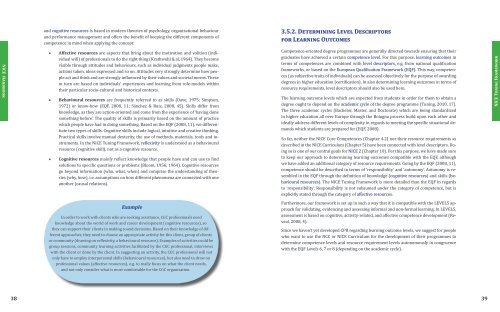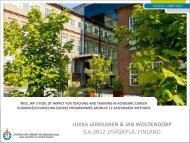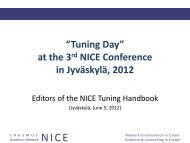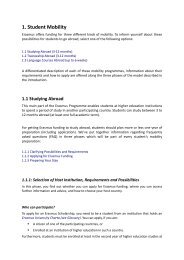NICE HANDBOOK â Academic training of Career ... - Nice-network.eu
NICE HANDBOOK â Academic training of Career ... - Nice-network.eu
NICE HANDBOOK â Academic training of Career ... - Nice-network.eu
You also want an ePaper? Increase the reach of your titles
YUMPU automatically turns print PDFs into web optimized ePapers that Google loves.
and cognitive resources is based in modern theories <strong>of</strong> psychology, organizational behaviourand performance management and <strong>of</strong>fers the benefit <strong>of</strong> keeping the different components <strong>of</strong>competence in mind when applying the concept:3.5.2. Determining Level Descriptorsfor Learning Outcomes<strong>NICE</strong> Handbook◆◆◆◆◆◆Affective resources are aspects that bring about the motivation and volition (individualwill) <strong>of</strong> pr<strong>of</strong>essionals to do the right thing (Krathwohl & al, 1964). They becomevisible through attitudes and behaviours, such as individual judgments people make,actions taken, ideas expressed and so on. Attitudes very strongly determine how peopleact and think and are strongly influenced by their values and societal norms. Thesein turn are based on individuals’ experiences and learning from role-models withintheir particular socio-cultural and historical contexts.Behavioural resources are frequently referred to as skills (Dave, 1975; Simpson,1972) or know-how (EQF, 2008, 11; Sánchez & Ruiz, 2008, 45). Skills differ fromknowledge, as they are action-oriented and come from the experience <strong>of</strong> ‘having donesomething before’. The quality <strong>of</strong> skills is primarily based on the amount <strong>of</strong> practicewhich people have had in doing something. Based on the EQF (2008, 11), we differentiatetwo types <strong>of</strong> skills. Cognitive skills include logical, intuitive and creative thinking.Practical skills involve manual dexterity, the use <strong>of</strong> methods, materials, tools and instruments.In the <strong>NICE</strong> Tuning Framework, reflexivity is understood as a behaviouralresource (cognitive skill), not as a cognitive resource.Cognitive resources mainly reflect knowledge that people have and can use to findsolutions to specific questions or problems (Bloom, 1956; 1964). Cognitive resourcesgo beyond information (who, what, when) and comprise the understanding <strong>of</strong> theories(why, how), i.e. assumptions on how different phenomena are connected with oneanother (causal relations).Competence-oriented degree programmes are generally directed towards ensuring that theirgraduates have achieved a certain competence level. For this purpose, learning outcomes interms <strong>of</strong> competences are combined with level descriptors, e.g. from national qualificationframeworks, or based on the European Qualification Framework (EQF). This way, competences(as subjective traits <strong>of</strong> individuals) can be assessed objectively for the purpose <strong>of</strong> awardingdegrees in higher education (certification). In also determining learning outcomes in terms <strong>of</strong>resource requirements, level descriptors should also be used here.The learning outcome levels which are expected from students in order for them to obtain adegree ought to depend on the academic cycle <strong>of</strong> the degree programme (Tuning, 2010, 17).The three academic cycles (Bachelor, Master, and Doctorate) which are being standardizedin higher education all over Europe through the Bologna process build upon each other andideally address different levels <strong>of</strong> complexity in regards to meeting the specific situational demandswhich students are prepared for (EQF, 2008).So far, neither the <strong>NICE</strong> Core Competences (Chapter 4.2) nor their resource requirements asdescribed in the <strong>NICE</strong> Curriculum (Chapter 5) have been connected with level descriptors. Doingso is one <strong>of</strong> our central goals for <strong>NICE</strong> 2 (Chapter 10). For this purpose, we have made sureto keep our approach to determining learning outcomes compatible with the EQF, althoughwe have added an additional category <strong>of</strong> resource requirements. Going by the EQF (2008, 11),competence should be described in terms <strong>of</strong> ‘responsibility’ and ‘autonomy’. Autonomy is resembledin the EQF through the definition <strong>of</strong> knowledge (cognitive resources) and skills (behaviouralresources). The <strong>NICE</strong> Tuning Framework is more detailed than the EQF in regardsto ‘responsibility’. Responsibility is not subsumed under the category <strong>of</strong> competence, but isexplicitly stated through the category <strong>of</strong> affective resources.<strong>NICE</strong> Tuning FrameworkExampleIn order to work with clients who are seeking assistance, CGC pr<strong>of</strong>essionals needknowledge about the world <strong>of</strong> work and career development (cognitive resources), sothey can support their clients in making sound decisions. Based on their knowledge <strong>of</strong> differentapproaches, they need to choose an appropriate activity for this client, group <strong>of</strong> clientsor community (drawing on reflexivity, a behavioural resource). Examples <strong>of</strong> activities could begroup sessions, community learning activities facilitated by the CGC pr<strong>of</strong>essional, interviewswith the client or done by the client. In suggesting an activity, the CGC pr<strong>of</strong>essional will notonly have to employ interpersonal skills (behavioural resources), but also need to draw onpr<strong>of</strong>essional values (affective resources), e.g. to really focus on what the client needs,and not only consider what is most comfortable for the CGC organisation.Furthermore, our framework is set up in such a way that it is compatible with the LEVEL5 approachfor validating, evidencing and assessing informal and non-formal learning. In LEVEL5,assessment is based on cognitive, activity-related, and affective competence development (Reveal,2008, 4).Since we haven’t yet developed CPR regarding learning outcome levels, we suggest for peoplewho want to use the NCC or <strong>NICE</strong> Curriculum for the development <strong>of</strong> their programmes todetermine competence levels and resource requirement levels autonomously in congruencewith the EQF Levels 6, 7 or 8 (depending on the academic cycle).38 39






